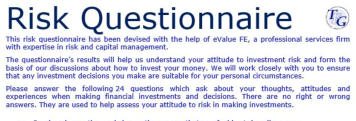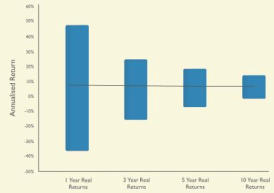
The Financial Group
We simplify all those essential financial decisions
THE EDUCATION SECTION
November 2016
A guide to Investment Risk & Return
What
is
Risk?
Over
the
past
few
years,
‘risk’
has
become
a
popular
term
in
the
context
of
investments.
This
is
in
part
due
to
the
fact
that
the
2008
financial
crisis
showed
how
many
investors
were
unsure
or
unclear
about
what
risks
they
had
been
taking
with
their
investments.
Before
2008
there
have
been
many
times
when
uncertainty
has
arisen
–
eg:
9/11
of
2001
&
Black
Monday
of
1987.
The
word
risk,
even
within
the
narrow
scope
of
investing,
can
be
viewed
in
many
different
ways.
One
distinction
we
can
make
is
between
investOR
risk
and
investMENT risk
.
What
is
investor
risk?
Investor
risk
can
be
described
as
the
possibility
of
not
being
able
to
match
your
future
outgoings with the savings pot you’ve accumulated for this purpose - eg: your pension fund.
This
risk
is
managed
by
financial
advisers
when
they
gather
information
regarding
the
future
cash
flow
requirements of a client, and advise accordingly.
What
is
investment
risk?
‘Investment
risk’
is
different
-
it
describes
the
fluctuations
in
value
of
a
portfolio
over
time.
For
many
of
our
clients,
the
main
concern
is
loss
of
capital.
While
this
is
applicable
in
the
case
of
highly
concentrated
investments
(such
as
a
few
stocks
or
shares)
it
is
less
applicable
in
the
case
of
a
diversified
portfolio.
Here,
the
risk
of
total
loss
is
spread
across
each
of
a
large
number
of
investments.
This
means
that
instead
of
looking
solely
at
potential
loss,
we
focus
on
the
predictability
of
expected
returns.
We
measure this predictability using volatility.
How do we work out the route forward?
The
starting
point
is
our
Risk
Questionnaire.
We
have
put
together
a
range
of
questions,
together
with
our
partners
FE
Analytics,
to
produce
a
report
that
we
use
as
a
discussion
document
that
we
can
talk
through
with
you
to
help
understand
your
thoughts
on
your
investments
&
the
‘risks’
that
you
are
happy
to
take
to
achieve
your
goals.
None
of
the
answers
are
‘set
in
stone’.
They
&
the
report
just
help
you
&
us
enormously
when we are discussing the best route forward.
Click
the
Risk
Questionnaire
image
if
you
would
like
to
complete
our
Risk
Questionnaire
&
receive
a
report
summarising your answers & our interpretaion of your Risk level.
What
is
volatility?
Mathematically,
volatility
is
the
standard
deviation
of
annual
returns.
(Wow!
Need
an
explanation?
Find
out
here
.)
Under
normal
market
conditions,
this
describes
the
range
of
returns
around
the
average you would expect to see in 2 years out of 3.
Clearly,
these
past
few
years
have
shown
that
markets
don’t
always
behave
‘normally’,
and
we
can
see
returns
which are much higher or lower than expected.
What
does
this
mean
for
you
as
an
investor?
There
is
a
need
to
find
a
balance
between
the
level
of
predictability
you
wish
to
have
in
your
investment
return,
and
the
level
of
return
you
are
aiming
for.
There
is
of
course
a
trade-off
to
be
made
here
-
asset
classes
with
highly
predictable
returns,
such
as
cash
or
gilts,
offer
little
by
way
of
a
‘premium’,
while
asset
classes
which
experience
greater
fluctuations,
such
as
equities,
can
offer higher returns, but with less ability to predict whether or not you’ll achieve these higher levels.
Managing
your
Investment
Risk.
Once
we
have
determined
the
level
of
predictability
you
wish
to
have,
the
aim
of
investing
is
then
to
manage
this
as
efficiently
as
possible.
In
other
words,
to
maximise
your
potential
return while maintaining the same level of predictability about that return.
There are 2 tools that are effective in achieving this -
diversification
and
compounding
.
•
Diversification.
Bond
prices,
which
benefit
from
falling
interest
rates
and
fear
in
equity
markets,
often
rise
while
equities
are
falling,
and
this
low
correlation
can
reduce
the
overall
portfolio
volatility
without
materially
impacting
the
expected
return.
This
effect
can
become
amplified
when
you
begin
to
introduce
alternative asset classes such as property or commodities.
A
balanced
portfolio,
comprising
of
equities,
bonds
and
alternatives,
should
therefore
produce
superior
returns per unit volatility compared with the individual asset classes.
•
Compounding
-
refers
to
holding
an
investment
for
a
longer
period
of
time,
meaning
there’s
a
greater
likelihood
of
achieving
the
expected
annual
return.
By
increasing
the
amount
of
time
that
the
investment
is
held
for,
the
impact
of annual variation in portfolio returns can be minimised.
The
chart
on
the
right
shows
the
maximum
and
minimum
annualised
real
returns
of
UK
equities
since
1985,
showing
how
the
return
on
an
investment
becomes
more
predictable as the time horizon increases.
The
average
annual
return
realised
over
this
timeframe
doesn’t
really
differ
and
sits
at
around
7%
per
annum,
but
holding
the
investment
for
10
years
rather
than
1,
3,
or
5
years
significantly
increases
the
likelihood
of
realising
the
expected annual return.
As always,
please do not hesitate to
contact us
if you would like further details or information.








- In the News
- The Housing Market
- The Education Section
- Income Drawdown
- ISAs
- Lisa & Help to Buy ISA
- Risk v Return
- Stamp Duty Land Tax
- Archive
- Oct 2011 State Pensions
- Nov 2011 Structured Products
- Dec 2011 Pound Cost Averaging
- Jan 2012 Trusts
- Feb 2012 ASU
- Mar 2012
- Apr 2012 House Surveys
- May 2012 Options at retirement
- Jun 2012 IHT
- July 2012 FSCS
- Aug 21012 Index
- Sep 2012 EU Gender Directive & I minus E
- Oct 2012 Interest Only mortgages
- Nov 2012 NEST
- Feb 2013 APR
- Apr 2013
- May 2013 Investing in Funds pt1
- June 2013 Investing in Funds pt2
- July 2014 New ISAs
![Close [x]](index_htm_files/close.png)









